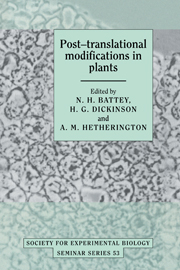Book contents
- Frontmatter
- Contents
- List of contributors
- List of abbreviations
- Preface
- Some roles of post-translational modifications in plants
- Signal transduction and protein phosphorylation in bacteria
- Roles of protein phosphorylation in animal cells
- The significance of post-translational modification of proteins by phosphorylation in the regulation of plant development and metabolism
- Post-translational modification of chloroplast proteins and the regulation of protein turnover
- Purification of a small phosphoprotein from chloroplasts and characterisation of its phosphoryl group
- Use of synthetic peptides to study G proteins and protein kinases within plant cells
- Activation of membrane-associated protein kinase by lipids, its substrates, and its function in signal transduction
- Distribution and function of Ca2+-dependent, calmodulin-independent protein kinases
- Phosphorylation of the plasma membrane proton pump
- The regulation of phosphoenolpyruvate carboxylase by reversible phosphorylation
- Protein phosphorylation and circadian rhythms
- Control of translation by phosphorylation of mRNP proteins in Fucus and Xenopus
- Regulation of plant metabolism by reversible protein (serine/threonine) phosphorylation
- Detection, biosynthesis and some functions of glycans N-linked to plant secreted proteins
- Biosynthesis, intracellular transport and processing of ricin
- Post-translational processing of concanavalin A
- The role of cell surface glycoproteins in differentiation and morphogenesis
- Ubiquitination of proteins during floral development and senescence
- Index
Phosphorylation of the plasma membrane proton pump
Published online by Cambridge University Press: 06 July 2010
- Frontmatter
- Contents
- List of contributors
- List of abbreviations
- Preface
- Some roles of post-translational modifications in plants
- Signal transduction and protein phosphorylation in bacteria
- Roles of protein phosphorylation in animal cells
- The significance of post-translational modification of proteins by phosphorylation in the regulation of plant development and metabolism
- Post-translational modification of chloroplast proteins and the regulation of protein turnover
- Purification of a small phosphoprotein from chloroplasts and characterisation of its phosphoryl group
- Use of synthetic peptides to study G proteins and protein kinases within plant cells
- Activation of membrane-associated protein kinase by lipids, its substrates, and its function in signal transduction
- Distribution and function of Ca2+-dependent, calmodulin-independent protein kinases
- Phosphorylation of the plasma membrane proton pump
- The regulation of phosphoenolpyruvate carboxylase by reversible phosphorylation
- Protein phosphorylation and circadian rhythms
- Control of translation by phosphorylation of mRNP proteins in Fucus and Xenopus
- Regulation of plant metabolism by reversible protein (serine/threonine) phosphorylation
- Detection, biosynthesis and some functions of glycans N-linked to plant secreted proteins
- Biosynthesis, intracellular transport and processing of ricin
- Post-translational processing of concanavalin A
- The role of cell surface glycoproteins in differentiation and morphogenesis
- Ubiquitination of proteins during floral development and senescence
- Index
Summary
Introduction
The plasma membrane proton pump (H+-ATPase) is the primary means by which metabolic energy is coupled to solute transport in plants and fungi. In animal cells, the plasma membrane sodium pump (Na+,K+-ATPase) plays a similar role. Thus, animal cells utilise sodium-coupled carriers for solute movement, whereas in plants and fungi these carriers are proton-coupled. Electrophysiological measurements indicate that in actively transporting cells, such as those of plant root hairs or rapidly dividing fungi, the proton pump may be the single greatest consumer of cellular ATP (Felle, 1982). The reliance of plants and fungi on the everpresent proton, and their rather large resting electric potential (−160 to −240 mV, interior negative), may account for their ability to survive in media with little nutritional value. These organisms are capable of scavenging low concentrations of nutrients; the proton pump is essential for this process. Genetic disruption experiments with a gene encoding the plasma membrane proton pump of yeast has provided conclusive evidence that this enzyme is essential for normal growth. The enzyme contains a single polypeptide of ca. Mr=100000 with conserved sequences and topology that place it within the P-type family of ion pumps (Sussman & Harper, 1989). Other members of this family include the animal plasma membrane Na+,K+-ATPase and Ca2+-ATPase.
Most higher plant cells grow at a much slower rate than laboratorygrown yeast. It seems likely that, in place of a rapid doubling time, plants emphasise a precise regulation of cellular growth rates, to ensure that the tissues and organs of this complex multicellular eukaryote form and develop in an orderly fashion.
- Type
- Chapter
- Information
- Post-translational Modifications in Plants , pp. 149 - 160Publisher: Cambridge University PressPrint publication year: 1993

